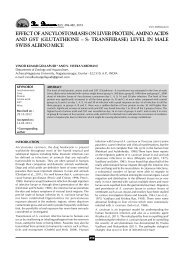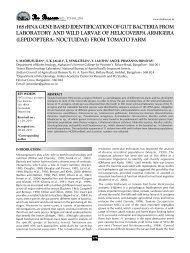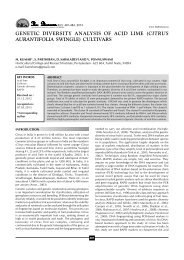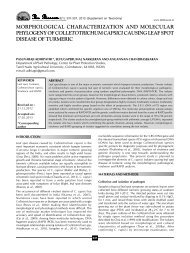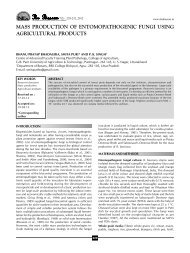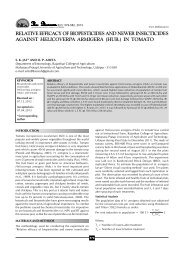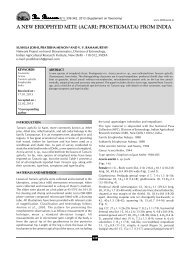full paper - THE BIOSCAN
full paper - THE BIOSCAN
full paper - THE BIOSCAN
You also want an ePaper? Increase the reach of your titles
YUMPU automatically turns print PDFs into web optimized ePapers that Google loves.
JURI DEVI et al.,<br />
Table 1: Showing frequency of occurrence of fungal species at different heights (cms) in the store houses of onion and<br />
ginger<br />
Height (cm)<br />
Fungi 0-level (ground) 500cms 1000cms 2000cms<br />
1. Alternaria alternata + + + + + - - - - - -<br />
2. A. solani + + + + + - - - - - -<br />
3. Aspergillus flavus + + + + + + + +<br />
4. A. niger + + + + + + + +<br />
5. A. terreus + + + + + + + +<br />
6. Botrytis cinerea + + + + + + +<br />
7. Cercospora sp. + + + + + + + - - -<br />
8. Cladosporium sp. + + + + + +<br />
9. Colletotrichum capsici + + + + + - - - - - -<br />
10. Curvularia lunata + + + + + + + + + +<br />
11. F. oxysporum + + + + + + + + + +<br />
12. F.moniliforme + + + + + + + + + +<br />
13. F. solani + + + + + + +<br />
14. F. zingiberi + + + + + + + + + +<br />
15. Helminthosporium sp. + + + + + + +<br />
16. Lasiodiplodia + + + + + + + - - - -<br />
theobromae<br />
17. Mucor mucedo + ++ + + + +<br />
18. Penicillium citrinum + + + + + + +<br />
19. Rhizopus stolonifer + + + + + + +<br />
20. Trichoderma sp. + + + + - - - - - -<br />
21. Trichothecium sp. + + + - - - - - -<br />
22. Verticillium theobromae ++++ ++ + + + +<br />
Exposure time: 1 minute<br />
Table 2: Showing frequency of occurrence of fungal species at different period of exposure - inside the store houses of<br />
onion and ginger<br />
Different period of exposure<br />
Fungi 0 minute 1 minute 2 minute 3 minute<br />
Alternaria alternata — + + + + + +<br />
A. solani — + + + +<br />
Aspergillus flavus — + + + + + + + + +<br />
A. niger — + + + + + + + +<br />
A. terreus — ++ + + + + + + +<br />
Botrytis cineria — + + + + + + + + +<br />
Cercospora sp. — + + + +<br />
Cladosporium sp. — + + + + + +<br />
Colletotrichum capsici — + + + + + +<br />
Curvularia lunata — + + + +<br />
Fusarium oxysporum — + + + + + + + + +<br />
F. moniliforme — + + + + + + + + +<br />
F. solani — + + + + + + + + +<br />
F. zingiberi — + + + + + + + + +<br />
Helminthosporium sp. — + + +<br />
Lasiodiplodia theobromae — — + + +<br />
Mucor mucedo — + + + +<br />
Penicillium citrinum — + + + + + +<br />
Rhizopus stolonifer — + + + + + + + +<br />
Trichoderma sp. — — + + +<br />
Trichothecium sp. — — + + +<br />
Verticillium theobromae — + + + + + +<br />
hand predominant species in the store houses of ginger were- Aspergillus niger, Fusarium oxysporum, F.<br />
solani, F. zingiberi, Lasiodiplodia sp. and Verticillium thebromae.<br />
The concentration of mycoflora was recorded highest from the month of March to October and gradually<br />
decline towards January. Certain genera like Cladosporium and Helminthosporium were predominant even<br />
550



